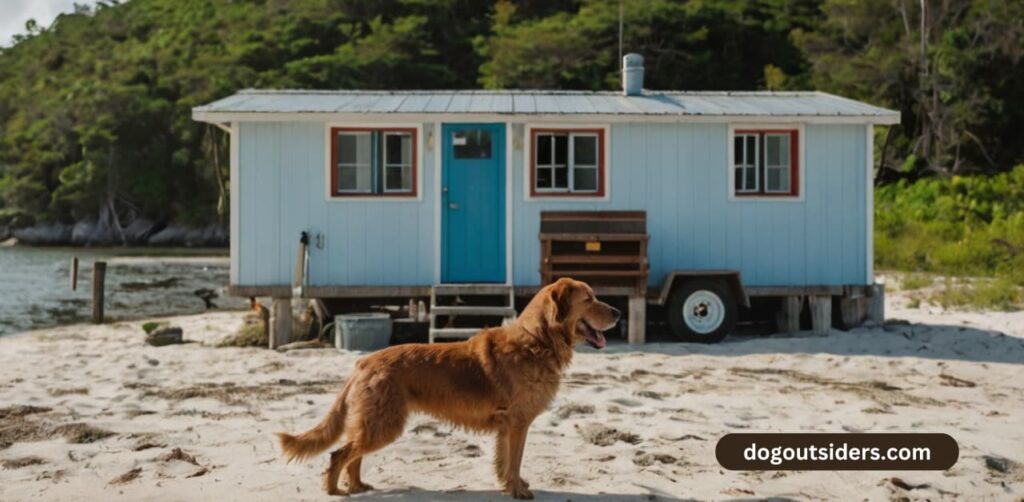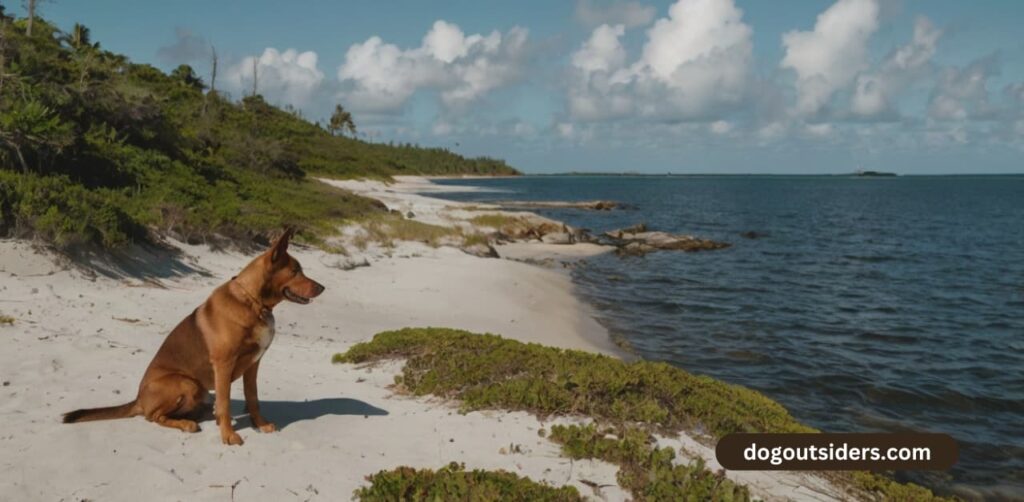How do you get to Dog Island? I’ve always been curious about this unique destination. It’s a place like dog island beach where furry friends roam free, and the vibe in this vacation area is all about fun and relaxation. I want to share my journey to this remote barrier island dog-friendly paradise, where several island residents live in a cottage among the barrier islands. From planning my trip to navigating the logistics of reaching the untouched dog island via the dog island ferry, every step was an adventure.
I’ll break down the best ways to reach Dog Island and other islands, including transportation options and tips for a smooth experience. Whether you’re a dog owner or just love canines, island residents will find valuable insights here on the remote barrier island. Join me as I explore how to make your visit to the remote barrier island unforgettable, including insights from island residents and a ride on the dog island ferry. Let’s dive into the details about the remote barrier island that will help you get there with ease, including the dog island ferry and insights from island residents.
Key Takeaways
- Plan Your Route: Familiarize yourself with Dog Island’s location and choose the best transportation option, whether it’s by boat or private ferry, to ensure a smooth journey.
- Check for Permits: Before you go, make sure to secure any necessary access permits, as these are crucial for visiting Dog Island legally and responsibly.
- Explore Unique Features: Take time to appreciate the island’s distinct natural features, such as its wildlife and landscapes, which make it a unique destination for nature lovers.
- Engage in Activities: Consider planning activities like hiking, birdwatching, or kayaking to fully enjoy the island’s offerings and make the most of your visit.
- Respect the Environment: Follow environmental tips provided in the article to minimize your impact on the island’s ecosystem and preserve its beauty for future visitors.
- Prepare for Your Visit: Make a checklist of what to bring based on the planning section, ensuring you have everything needed for a successful trip to Dog Island.
Understanding Dog Island’s Location

Proximity to St. George Sound
Dog Island lies approximately 5 miles from St. George Sound. This distance makes it relatively close, yet far enough to require planning for travel on the dog island ferry for island residents. The island is part of the Gulf Coast, situated off the coast of Florida. I find this distance interesting because it highlights how accessible yet isolated Dog Island can feel.
The waters surrounding Dog Island are often calm, making boat travel easier. Many visitors prefer using small boats or kayaks to reach the island. The scenic route across the water offers a unique view of the coastline and wildlife, including the dog island ferry for island residents.
Transportation Methods
No bridge connects Dog Island to the mainland. This absence emphasizes the need for alternative transportation methods. Visitors must rely on boats or ferries to access the island. I think this dog island ferry adds a layer of adventure to the journey.
Ferry rides to Dog Island are provided by local services, which operate frequently, particularly during the busy tourist seasons. For travelers seeking greater flexibility in their schedules, private boat rentals, such as the dog island ferry, are also an option.
Geographical Features
Dog Island has geographical features that contribute to its unique accessibility. The island is relatively flat with sandy beaches and dunes. Dense vegetation covers parts of the island, providing habitat for various wildlife species.
The Dog Island Lighthouse, built in 1883, stands as a historical landmark on the island. It serves as a navigational aid for passing ships, including the dog island ferry, and adds charm to the area. Exploring the lighthouse and taking the dog island ferry can be a rewarding experience for visitors interested in maritime history. Another notable feature is the dog island shipwreck survey conducted in recent years. This survey aims to identify shipwrecks around Dog Island’s shores, revealing its rich maritime past. Learning about these wrecks, including the dog island ferry, can deepen one’s appreciation for the area’s history.
Human Presence
Human presence on Dog Island is minimal compared to other coastal areas. Few permanent residents live there, ensuring that nature remains largely untouched, except for the dog island ferry. Most visitors come for short stays, enjoying activities like fishing, hiking, birdwatching, and taking the dog island ferry.
I appreciate this aspect of Dog Island; it feels like an escape from modern life. The tranquility allows for relaxation and connection with nature.
Transportation Options to Dog Island
Dog Island Ferry
Ferry services provide a primary means of reaching Dog Island. The dog island ferry operates regularly from nearby locations. This option is popular among tourists and locals alike. The trip offers scenic views of the coastline. I find the ferry ride enjoyable, as it allows me to relax before arriving at my destination.
Travelers can expect a short journey. It typically takes about 30 minutes to reach the island. Reservations are recommended, especially during peak seasons. Prices vary based on the time of year and demand. Generally, round-trip fares for the dog island ferry range from $20 to $40 per person.
Dog Island Car Ferry
For those traveling with vehicles, the dog island car ferry is an excellent choice. This service allows visitors to bring their cars, making it easier to explore the island. The car ferry accommodates various vehicle sizes, including trucks and trailers.
The convenience of having a personal vehicle cannot be overstated. I often prefer this option for its flexibility. With my car, I can carry more supplies and enjoy spontaneous adventures around the island.
Costs for the car ferry depend on vehicle size. Expect to pay between $60 and $100 for a round trip on the dog island ferry. It’s wise to check availability in advance for the dog island ferry since space can fill up quickly during busy times.
Dog Island Airport
Another option is flying into the dog island airport. Small aircraft operate flights from mainland airports. This route is faster than traveling by boat, like the dog island ferry, but may be less common due to higher costs.
Flying can be a great choice for groups or families needing quick access to the dog island ferry. However, limited flight schedules may affect plans. Checking flight availability ahead of time is essential.
Private Boat Charters
Private boat charters offer a more personalized travel experience. Many local companies, including the dog island ferry, provide this service, allowing travelers to set their schedules. Charters can accommodate small groups and provide unique experiences like fishing, sightseeing along the way, or the dog island ferry.
Costs for private charters vary widely based on duration and amenities offered. Rates typically start at around $200 for a few hours but can increase significantly for longer trips or larger groups.
Kayaking
Kayaking is another popular method for reaching Dog Island. Many visitors enjoy paddling through the waters surrounding the island. Rentals are available at nearby beaches and marinas.
This option appeals to adventure seekers looking for an active experience. I once kayaked to Dog Island with friends; it was challenging yet rewarding when we arrived.
Access Points and Permits

Beach Access
Dog Island offers several designated launch points for those wanting to visit. Popular spots include the Carrabelle Beach and St. George Island State Park. Both locations provide easy access to the waters surrounding Dog Island.
From Carrabelle Beach, it takes about a 30-minute boat ride to reach the island. Many local marinas also rent boats or kayaks, making it convenient for visitors. I often recommend checking with local rental services for availability during peak seasons.
St. George Island State Park has its own launch area. This site is known for its beautiful scenery and calm waters. It’s an excellent choice for kayaking. The park’s facilities make it a comfortable starting point for your trip.
Necessary Permits
Accessing Dog Island may require specific permits, especially if you’re using motorized boats. The Florida Fish and Wildlife Conservation Commission manages these regulations. They ensure that all activities align with environmental protection efforts.
For kayaking or paddleboarding, no special permits are typically needed. However, it’s wise to check local guidelines before heading out. I always find it helpful to verify what is required ahead of time to avoid any surprises.
If you plan on fishing near Dog Island, a fishing license is mandatory. Licenses can be obtained online through the Florida Fish and Wildlife website or at local vendors. Having this ready will enhance your experience without interruptions.
Local Guidelines
Before planning your trip to Dog Island, familiarize yourself with local guidelines. These rules help protect the island’s ecosystem and ensure visitor safety. Understanding them can prevent potential fines or issues during your visit.
For instance, certain areas around Dog Island may have restrictions on camping and fires. It’s essential to respect wildlife habitats as well. I always carry a printed copy of the local regulations when I go out to ensure compliance.
Checking weather conditions is also crucial before embarking on your journey. Sudden changes in weather can impact boat travel significantly. Planning ahead helps ensure a safe and enjoyable experience.
Unique Features of Dog Island
Historical Significance
Dog Island boasts a rich history. Evidence suggests ancient human presence dates back thousands of years. Archaeological findings indicate that Native Americans inhabited the area long before European settlers arrived. Their tools and artifacts provide insight into their daily lives and connection to the land.
I find it fascinating how these remnants link us to the past. They remind us of the island’s longstanding relationship with its inhabitants.
Limited Structures
The number of structures on Dog Island is minimal. Most buildings align with the island’s charm and simplicity. The Pelican Inn stands out as a key tourist spot. This inn offers unique accommodations for visitors seeking a peaceful retreat.
Island residents emphasize the importance of preserving this tranquility. The limited development helps maintain an unspoiled environment, inviting guests to unwind.
Name Origins
The name “Dog Island” originates from its early history. Early Spanish explorers noted the presence of wild dogs on the island. These canines roamed freely, leading to the name that endures today.
Understanding this origin adds depth to my appreciation for the island. It reflects both its natural beauty and historical context.
Barrier Islands
Dog Island is part of a series of remote barrier islands along Florida’s Gulf Coast. These islands protect the mainland from storms and erosion. They also provide unique ecosystems that support diverse wildlife.
Visitors often enjoy exploring these barrier islands by kayak or boat. Each trip offers opportunities to see various species in their natural habitats.
Untouched Nature
Nature remains largely untouched on Dog Island. Its pristine beaches attract both humans and pets alike. Many people bring their dogs to enjoy the sandy shores and warm sun.
The island wraps around beautiful coastlines, making it an ideal spot for relaxation. I appreciate how quiet it feels compared to more crowded beaches nearby.
Community Life
Several island residents cherish their way of life here. They prioritize community and environmental stewardship. Many engage in activities like fishing, kayaking, and birdwatching.
The Dog Island Wren, a small bird native to this region, thrives in this environment. Birdwatchers often visit to catch a glimpse of this elusive species.
Exploring Natural Attractions

Unspoiled Beaches
Dog Island boasts unspoiled beaches that attract visitors seeking tranquility. The island’s shores are often quiet, offering a serene escape from the bustling mainland. I find these beaches perfect for long walks or simply relaxing while listening to the waves.
The natural beauty of these beaches enhances the overall experience. Sand and water blend seamlessly, creating a picturesque landscape. Many travelers appreciate this untouched environment, which feels like a hidden gem.
Bird Sanctuary
This island serves as a vital bird sanctuary. Various bird species nest here, making it an ideal spot for birdwatching. Observers can see herons, egrets, and other shorebirds in their natural habitat.
The presence of these birds reflects the island’s commitment to conservation. Federal wildlife refuge status protects their nesting areas. This ensures that future generations can enjoy the same sights I cherish during my visits.
Sea Turtle Nesting Area
Dog Island is also recognized as a sea turtle nesting area. From May to October, turtles come ashore to lay eggs. This event captivates many nature enthusiasts. Witnessing this process is awe-inspiring and highlights the importance of protecting such habitats.
Visitors should respect the nesting sites during their stay. Keeping distance helps ensure the turtles’ safety and successful hatching of eggs. I always remind fellow travelers about this responsibility when we explore together.
Coastal Ecosystems
Diverse ecosystems thrive on Dog Island. Protected vegetation plays a significant role in maintaining its beauty. The island features salt marshes, dunes, and maritime forests that support various wildlife.
Exploring these ecosystems reveals unique flora and fauna. Each visit uncovers something new and exciting for me. The interplay between land and sea creates stunning coastal landscapes that are worth experiencing firsthand.
Resort and Rentals
Accommodations on Dog Island include charming cottages and beach rentals. These options provide comfortable stays amidst nature’s splendor. Many visitors prefer staying close to the shore for easy access to activities like fishing or kayaking.
Boat trips around the island offer another way to appreciate its natural attractions. These excursions allow guests to view marine life up close while enjoying the scenic coastline. I often recommend boat trips to friends looking to make the most of their time on the island.
Planning Your Visit
Essential Gear
Preparing for a self-sufficient trip is crucial. Pack all necessary gear and supplies before heading to Dog Island. Bring enough food, water, and personal items. I always make a checklist to ensure I don’t forget anything important. A first-aid kit is also essential for safety.
Consider bringing outdoor equipment like fishing rods or kayaks if you plan to explore the bay. Don’t forget your pet’s needs if you’re taking them along. Having everything ready will enhance your experience.
Timing Your Trip
Researching the best times to visit can greatly impact your vacation. Dog Island has a warm climate, but weather patterns vary throughout the year. The peak season often runs from late spring to early fall. During this time, families flock to the mainland vacation areas, making it busier.
I prefer visiting in the shoulder seasons for fewer crowds and pleasant weather. Spring offers blooming wildflowers, while fall showcases stunning sunsets. Each season provides unique activities and experiences.
Creating an Itinerary
Creating an itinerary helps organize your trip efficiently. Outline transportation methods, accommodations, and planned activities. Consider how you will get to Dog Island from the mainland. Ferries operate regularly, providing easy access.
After reaching the island, choose where to stay. Options range from cozy cabins to camping sites. I find that booking in advance secures better choices, especially during busy periods.
List activities that match your interests. Popular options include hiking trails, birdwatching, and beachcombing along the bay. Ensure your schedule allows for relaxation too; downtime is essential on any vacation.
Transportation Options
Transportation plays a vital role in planning your visit. Depending on where you start, options may vary. Many visitors drive to nearby docks before taking a ferry to Dog Island.
I recommend checking ferry schedules beforehand as they can change based on weather conditions or demand. Some travelers might consider private boats for flexibility, but this requires more preparation.
Accommodations
Accommodations should align with your preferences and budget. Options range from rustic cabins to glamping sites near the bay. Research each option thoroughly to find what suits you best.
Booking ahead is wise during peak seasons when accommodations fill quickly. I have learned that reading reviews helps gauge quality and service.
Recommended Activities
Fishing
Fishing is a popular activity at Dog Island. Anglers can enjoy the bay water teeming with various fish species. I remember my first fishing trip there. The thrill of reeling in a big catch is unforgettable. Many prefer deep-sea fishing, while others enjoy casting from the shore. Local guides often offer charters for those seeking expert advice.
Water Sports
Water sports are abundant on Dog Island. Surfing and skimboarding attract both beginners and experienced enthusiasts. The waves provide ideal conditions for all skill levels. I found that renting equipment is easy and affordable. Kayaking is another great option. Paddling through the calm waters allows for a unique view of the coastline.
Wildlife Observation
Wildlife observation offers a chance to connect with nature. Birdwatching is particularly rewarding on Dog Island. Numerous species flock to the area, especially during migration seasons. I often bring my binoculars to spot egrets and herons. Turtle spotting is also common, especially during nesting season from May to October. Witnessing turtles hatch is an emotional experience.
Historical Exploration
Exploring historical sites adds depth to your visit. Dog Island has remnants of its past that tell fascinating stories. Old structures remind visitors of the island’s history as a fishing community. Guided tours provide insights into these landmarks, enriching the experience. I recommend taking a walk along the shore to find unique artifacts left by previous inhabitants.
Natural Landmarks
Natural landmarks are another highlight of Dog Island. The beaches boast stunning views and pristine sands. Walking trails lead to breathtaking vistas overlooking the bay water. Each trail offers its own unique scenery and wildlife encounters. I often take time to relax on the beach while watching the sunset over the horizon.
Relaxation
Relaxation is essential during any visit to Dog Island. Finding a quiet spot on the beach allows one to unwind completely. Listening to the sound of waves crashing against the shore brings peace of mind. I often use this time for reflection or reading a good book.
Environmental Tips for Visitors
Outdoor Area
Visitors should enjoy the outdoor area responsibly. The island features stunning landscapes and diverse wildlife. I recommend taking a moment to appreciate the beauty around you.
Leaving no trace is crucial. Every visitor can make a difference by cleaning up after themselves. This means packing out all trash and not leaving anything behind. Even small items like food wrappers can harm the environment.
Respecting wildlife is equally important. Animals on Dog Island are vulnerable, especially in their natural habitats. Observing from a distance prevents unnecessary stress to these creatures. I find that using binoculars enhances the experience without intruding.
Bird Sanctuary
Dog Island serves as a critical bird sanctuary. Many migratory species rely on this area for nesting and feeding. Visitors must be aware of their impact on these birds.
Staying on designated paths helps protect the delicate ecosystems found here. Walking off trails can damage native plants and disturb nesting sites. I often remind myself to stick to marked routes during my visits.
Using eco-friendly products also contributes positively to the environment. Biodegradable soaps and reusable containers minimize pollution. I have switched to using refillable water bottles, which reduces plastic waste significantly.
Responsible Behavior
Practicing responsible behavior enhances everyone’s experience on Dog Island. It fosters a sense of community among visitors who care about preserving nature.
Keeping noise levels down is essential. Loud sounds can scare away wildlife and disrupt their natural behaviors. I notice that when I speak softly, I often spot more animals engaging in their daily activities.
Educating oneself about local flora and fauna enriches the visit. Understanding what plants and animals inhabit the island leads to greater appreciation. I make it a point to read up before my trips, which makes me more mindful of my surroundings.
Closing Thoughts
Dog Island is a hidden gem that offers a unique escape for nature lovers. I’ve covered everything from how to get there to the must-see attractions. This island is not just about its stunning landscapes; it’s about creating unforgettable memories.
I encourage you to plan your trip soon. Embrace the adventure, explore the natural beauty, and respect the environment. Dog Island awaits with open arms for those ready to discover its charm. Don’t miss out—pack your bags and start your journey today!
Frequently Asked Questions
You can reach Dog Island by boat or private watercraft. There are local ferry services that operate from nearby coastal towns, providing convenient access for visitors.
Yes, a permit is required to visit Dog Island. Permits can be obtained online or at designated access points before your trip.
Transportation options include personal boats, local ferries, and guided tours. Check schedules in advance for the best travel times.
Dog Island does not have traditional accommodations. Visitors typically camp or stay in nearby towns. Plan ahead for lodging if needed.
Dog Island is known for its pristine beaches, diverse wildlife, and stunning natural landscapes. It’s an ideal spot for nature lovers and outdoor enthusiasts.
Recommended activities include birdwatching, kayaking, beachcombing, and hiking. Enjoy the serene environment while exploring its natural beauty.
To minimize your impact, follow Leave No Trace principles. Stay on marked trails, pack out all trash, and respect wildlife habitats during your visit.






